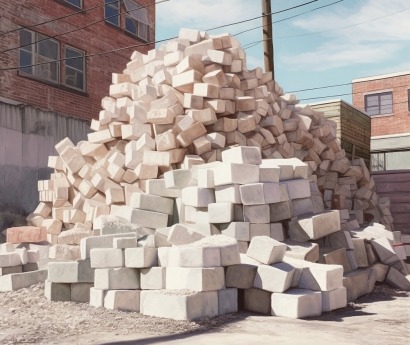
In fact, the cement industry accounts for 8% of global CO2 emissions. Concrete is necessary to build strong structures, so what’s the alternative? There are numerous options on the market. Here are six sustainable substitutes for traditional concrete and how to use them.
Hemp has become a sustainable alternative in numerous industries. For example, you can find clothes made from hemp in textile factories. Manufacturers also use hemp for paper, food, biofuel and concrete. You only need 60 to 90 days to produce hemp fibers, and you can grow this crop nearly anywhere in the world. The quick production makes it accessible for industries like construction.
Hemp concrete or hempcrete uses hemp hurds and binds them with lime, water and additives like sand to make the concrete alternative. Hempcrete uses much less water than typical concrete and is much lighter, making it easier for construction crews to handle.
In construction, contractors often use hempcrete for insulation. Lime is dense, giving the hempcrete excellent thermal properties. You can use hempcrete for floors, walls and roofs to control your house’s temperature. Home and office buildings often use hempcrete for partition walls. These walls separate rooms needing different environments, such as a bathroom and a common area.
Over time, most concrete structures form cracks. The most common causes of cracks are shrinkage and stress. When poured, the concrete may have dried too quickly — or the contractors added too much water. Regardless, cracks are the last thing you want to see. How can you repair them? One solution is to use self-healing concrete.
As the name suggests, self-healing concrete repairs itself when cracks occur. This material uses bacterial reactions to mend damage and extend the concrete’s life. Self-repair means moisture and chemicals are less likely to deteriorate self-healing concrete. You’ll spend much less time on maintenance and reduce resource consumption by reducing the need for repairs.
A 2019 Journal of Building Engineering Study examined self-healing concrete, concluding that it benefits construction through sustainability, environmental friendliness and energy-saving traits. Contractors often use self-healing concrete for bridges and roads because of the frequent heavy loads. You can also see it in marine structures like harbors and piers due to the harsh moisture and salty conditions that accelerate concrete’s deterioration.
Another popular concrete alternative is ash concrete or ashcrete. This material combines fly ash from coal combustion with lime and water to produce a durable structure. Ashcrete is sustainable because it repurposes coal waste and reduces the energy-intensive process of typical concrete production. It also uses less water. Research shows fly ash concrete requires about 10% less water than traditional concrete.
Contractors use fly ash concrete as a partial substitute for Portland cement. Ashcrete is dense and durable, ideal for road construction and structural elements like columns and beams. You can also use ashcrete to produce masonry units like blocks and bricks for walls, partitions and more.
Concrete is popular in the building sector because it’s low maintenance. During its lifetime, you won’t have to perform much upkeep. When finding concrete alternatives, selecting materials with similar durability is imperative. That’s what you get with fiber cement.
This concrete alternative typically contains Portland cement, water, fly ash and wood pulp. The wood pulp contributes to durability because its cellulose fibers act as reinforcement. Fiber cement resists cracking and warping in most climates because of the wood fibers’ strength. For example, fiber cement is optimal in coastal climates becauseit holds strong against rain and salt, which generally cause erosion.
Fiber cement’s durability makes it popular for siding and roofing. Many contractors use fiber cement as exterior cladding in residential and commercial structures. You can also employ fiber cement for interior cladding, providing high-quality finishes for walls and ceilings.
Many alternatives aim to reduce the environmental impact of concrete. What if you could eliminate the adverse effects and turn them into positives? You can achieve carbon negativity through Ferrock. This type of concrete comes from recycled steel and glass to produce a strong material. A 2020 study finds Ferrock has better compressive strength than traditional concrete.
Ferrock is relatively new in construction, so experts are still finding new ways to employ it. So far, Ferrock has been helpful for pavements and walkways to endure high foot traffic. You can also use Ferrock for load-bearing structures like walls, beams and columns. The compressive strength offers excellent durability in construction.
Ferrock has become popular because of its environmental benefits. The material absorbs CO2 from the atmosphere and converts it into stable minerals. This sequestration process makes Ferrock carbon negative, removing CO2 from the air.
Bamboo has quickly risen as a sustainable material in construction. Contractors use the plant for flooring, roofing, scaffolding and more. Bamboo is sustainable because it grows fast in nature, and you can regenerate it after harvesting. Once established, bamboo only needs about two or three months to reach maturity. Its sustainability has made it an attractive option for builders looking for concrete alternatives.
Bamboo concrete is popular because it has excellent tensile strength. It’s lighter than traditional concrete and has terrific flexibility because of its internal fibers. Using bamboo concrete is wise in earthquake-prone and humid areas due to its durability and resistance to corrosion. A 2021 Materials Today study finds bamboo concrete provides strength, durability and flexibility when used as a reinforcement material.
Bamboo’s rise has led numerous contractors to employ this concrete on building sites. Constructors use bamboo concrete for flooring through slabs or tiles and roofing through shingles or tiles. You can also use bamboo concrete outside for pavements, walkways, garden borders and other elements.
The building sector is rapidly moving towards more sustainable construction practices. Concrete’s negative environmental impact has led many contractors to seek sustainable alternatives. These six substitutions demonstrate concrete options that are better for the planet.

